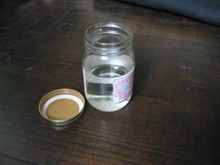 Wait. Déja vu, right? You saw that picture of the jar yesterday in my post entitled “my ultra cool reusable cup?” Guess what? My cup and my water bottle? They are the same thing! Two for the price of one. Double economy!
Wait. Déja vu, right? You saw that picture of the jar yesterday in my post entitled “my ultra cool reusable cup?” Guess what? My cup and my water bottle? They are the same thing! Two for the price of one. Double economy!
I dip with my jar into the nearest deli and ask them to fill it from the tap, or into a restaurant. I get all the water I want and not a single plastic bottle ends up in the trash. Of course, I could buy some sort of a nalgene bottle but then I wouldn’t qualify for the “ultra cool” description (and I’d be breaking the No Impact no buying anything new rule). Plus, by using the jar, in addition to getting to add the words ultra cool, as I said yesterday, I do a positive thing by taking something—the jar—out of the trash or recycling stream, saving energy (remember, what makes it ultra-cool is that it would have ended up in the landfill or the recycling truck–buying a new jar or a steel bottle for the purpose takes energy and materials).
Here are some reasons, taken from the Earth Policy Institute, that I avoid bottled water:
- Although in the industrial world bottled water is often no healthier than tap water, it can cost up to 10,000 times more. At as much as $2.50 per liter ($10 per gallon), bottled water costs more than gasoline.
- In contrast to tap water, which is distributed through an energy-efficient infrastructure, transporting bottled water long distances involves burning massive quantities of fossil fuels. Nearly a quarter of all bottled water crosses national borders to reach consumers, transported by boat, train, and truck.
- Making bottles to meet Americans’ demand for bottled water requires more than 1.5 million barrels of oil annually, enough to fuel some 100,000 U.S. cars for a year. Worldwide, some 2.7 million tons of plastic are used to bottle water each year.
- According to the Container Recycling Institute, 86 percent of plastic water bottles used in the United States become garbage or litter. Incinerating used bottles produces toxic byproducts such as chlorine gas and ash containing heavy metals. Buried water bottles can take up to 1,000 years to biodegrade.
- The rapid growth in this industry means that water extraction is concentrated in communities where bottling plants are located. Farmers, fishers, and others who depend on water for their livelihoods suffer from the concentrated water extraction when water tables drop quickly.
- Tap water is more strictly regulated for health standards than bottled water.
Need more convincing? Check out Lighter Footstep’s Five Reasons to Not Drink Bottled Water.
By the way, Idyllopus, a writer who apparently would rather procrastinate by writing mean things about me on her blog than finish her next book (and I mean that in the most understanding way), posted this funny video about making your own reusable cup. She doesn’t say where you can get the Toys R Us catalog if you have canceled your junkmail (PS sorry, Idyllopus, but I’m with your son on liking the second version of the video better).
PS If you think more people should read this blog, as I do, then please email it around, favorite it on Technorati, Digg it, Stumble it, and add it to Del.icio.us using the links below. Thanks!
PPS You can visit the blogs that have linked to this post and see what other people are writing about it by clicking on Technorati links below.